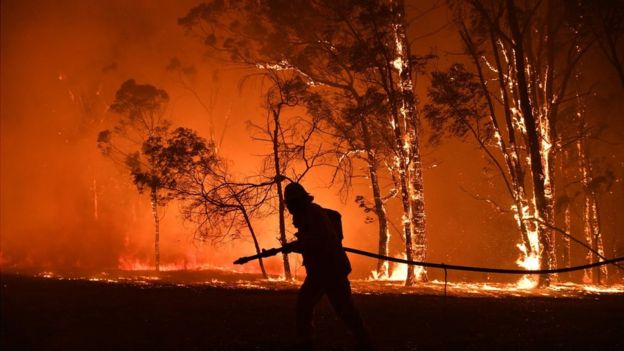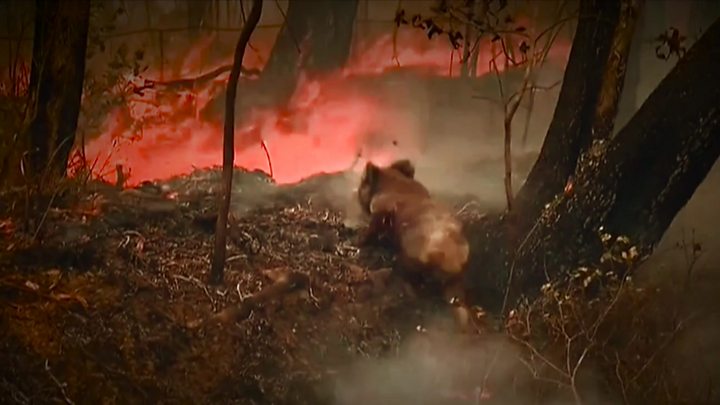Analogia Malenga
JF-Expert Member
- Feb 24, 2012
- 5,000
- 9,862
Ni kawaida kwa Australia kupata majanga ya moto, kwa kile kipindi ambacho kinafahamika kwa jina la fire season, Msimu wa moto. Lakini mwaka huu msimu huu wa moto ni mbaya kuliko yote, hali inayofanya kuvunja rekodi.
Kwa hivi sasa Australia inapambana na msimu mgumu wa moto, unaosababishwa na kupanda kwa joto na mieze ya ukame uliokithiri.
Nchi hiyo inazidi kupata joto Zaidi na Zaidi, na inaendelea kuwa hivyo. Japo moto ni kitu cha kawaida kwa hali ya hewa ya Australia wanasayansi walishaonya kuwa kipindi hiki moto wake utakuwa mkali na utaripuka mara nyingi Zaidi
Tuongelee yanayoendelea Australia, nchi ambayo inateseka kwa kuvunja rekodi ya kuungua kwa moto hadi hivi sasa. Moto uliozuka hivi karibuni umeangamiza mabilioni ya wanyama na kutoa Zaidi ya tani 250 za Carbondioxide (CO2)
ZAIDI SOMA
Australia is fighting one of its worst bushfire seasons, fuelled by record-breaking temperatures and months of severe drought.
Here's a very simple guide to what's going on:
Where are the fires?
The fires burn along stretches of the eastern and southern coast, which is where most of the population lives. This includes areas around Sydney and Adelaide.
Since September fires have killed at least 19 people and dozens remain missing.

More than four million hectares have burned in New South Wales alone - one hectare is roughly the size of a sports field.
To put that in perspective: some 900,000 hectares burned in the 2019 Amazon fires and around 800,000 hectares in 2018 in California.
Why are the fires so bad?
Australia has always experienced bushfires - it has what's known as a fire season - but this year they are a lot worse than normal.
Sydney has been covered by thick smoke from bushfires outside of the city.
The immediate cause is weather, specifically a phenomenon known as the Indian Ocean Dipole, which has meant a hot, dry spell.
This year, Australia twice set a new temperature record: an average maximum of 40.9C was recorded on 17 December, broken a day later by 41.9C.
That comes on top of a long period of drought. Some fires are also started deliberately.
How are the fires fought?
Firefighters are spraying water and fire retardant from planes and helicopters as well as from the ground.
But fighting bush fires is extremely difficult and often authorities have to focus on just stopping the spread, rather than putting the fire out.
The spread can for instance be contained by digging earth boundaries to stop the flames from spreading. The priority is saving lives.
Who is doing the work?
Professional firefighters are the first in line to battle the flames, but they are outnumbered by the thousands of volunteers. Three of them have died.
There's also help coming from abroad: the US, Canada, and New Zealand have sent firefighters to help.
Australia's police, military and navy are involved in rescue and evacuation efforts.
Is this climate change?
The overwhelming scientific consensus is that rising levels of CO2 are warming the planet.
Australia has been getting hotter over recent decades and is expected to continue doing so.
While fires are a natural part of the Australian weather cycle, scientists have long warned that this hotter, drier climate will contribute to fires becoming more frequent and more intense.
The more extreme weather patterns and higher temperatures increase the risk of bushfires and allow them to spread faster and wider.
How badly affected is the wildlife?
While people can flee the fires and are being evacuated if need be, the flames are devastating wildlife in the affected areas.
Fast movers like kangaroos can often flee the fires unless they get trapped and are surrounded by flames. Koalas are slow-moving and often die in the flames.

A woman rushed into the bush to rescue a koala crying out for help
But the fires don't only kill animals directly, they also destroy the habitat, leaving the survivors vulnerable even once the fires have gone.
One academic study estimated that nearly 500 million animals have already died in New South Wales alone. Untold numbers of cattle and sheep are lost.
What is the government doing?
Each state is running its own emergency operation - New South Wales is officially in a state of emergency.
Prime Minister Scott Morrison has promised better funding for firefighting and payouts for volunteer firefighters.
But the national government has come under strong criticism from its opponents that it's not been doing enough against climate change.
The country is one of the world's biggest per capita greenhouse gas emitters but under international agreements it has committed itself to reduction targets.
Mr Morrison has repeatedly defended his government's stance.
Source BBC
Kwa hivi sasa Australia inapambana na msimu mgumu wa moto, unaosababishwa na kupanda kwa joto na mieze ya ukame uliokithiri.
Nchi hiyo inazidi kupata joto Zaidi na Zaidi, na inaendelea kuwa hivyo. Japo moto ni kitu cha kawaida kwa hali ya hewa ya Australia wanasayansi walishaonya kuwa kipindi hiki moto wake utakuwa mkali na utaripuka mara nyingi Zaidi
Tuongelee yanayoendelea Australia, nchi ambayo inateseka kwa kuvunja rekodi ya kuungua kwa moto hadi hivi sasa. Moto uliozuka hivi karibuni umeangamiza mabilioni ya wanyama na kutoa Zaidi ya tani 250 za Carbondioxide (CO2)
ZAIDI SOMA
Australia is fighting one of its worst bushfire seasons, fuelled by record-breaking temperatures and months of severe drought.
Here's a very simple guide to what's going on:
Where are the fires?
The fires burn along stretches of the eastern and southern coast, which is where most of the population lives. This includes areas around Sydney and Adelaide.
Since September fires have killed at least 19 people and dozens remain missing.

More than four million hectares have burned in New South Wales alone - one hectare is roughly the size of a sports field.
To put that in perspective: some 900,000 hectares burned in the 2019 Amazon fires and around 800,000 hectares in 2018 in California.
Why are the fires so bad?
Australia has always experienced bushfires - it has what's known as a fire season - but this year they are a lot worse than normal.
Sydney has been covered by thick smoke from bushfires outside of the city.
The immediate cause is weather, specifically a phenomenon known as the Indian Ocean Dipole, which has meant a hot, dry spell.
This year, Australia twice set a new temperature record: an average maximum of 40.9C was recorded on 17 December, broken a day later by 41.9C.
That comes on top of a long period of drought. Some fires are also started deliberately.
How are the fires fought?
Firefighters are spraying water and fire retardant from planes and helicopters as well as from the ground.
But fighting bush fires is extremely difficult and often authorities have to focus on just stopping the spread, rather than putting the fire out.
The spread can for instance be contained by digging earth boundaries to stop the flames from spreading. The priority is saving lives.
Who is doing the work?
Professional firefighters are the first in line to battle the flames, but they are outnumbered by the thousands of volunteers. Three of them have died.
There's also help coming from abroad: the US, Canada, and New Zealand have sent firefighters to help.
Australia's police, military and navy are involved in rescue and evacuation efforts.
Is this climate change?
The overwhelming scientific consensus is that rising levels of CO2 are warming the planet.
Australia has been getting hotter over recent decades and is expected to continue doing so.
While fires are a natural part of the Australian weather cycle, scientists have long warned that this hotter, drier climate will contribute to fires becoming more frequent and more intense.
The more extreme weather patterns and higher temperatures increase the risk of bushfires and allow them to spread faster and wider.
How badly affected is the wildlife?
While people can flee the fires and are being evacuated if need be, the flames are devastating wildlife in the affected areas.
Fast movers like kangaroos can often flee the fires unless they get trapped and are surrounded by flames. Koalas are slow-moving and often die in the flames.

A woman rushed into the bush to rescue a koala crying out for help
But the fires don't only kill animals directly, they also destroy the habitat, leaving the survivors vulnerable even once the fires have gone.
One academic study estimated that nearly 500 million animals have already died in New South Wales alone. Untold numbers of cattle and sheep are lost.
What is the government doing?
Each state is running its own emergency operation - New South Wales is officially in a state of emergency.
Prime Minister Scott Morrison has promised better funding for firefighting and payouts for volunteer firefighters.
But the national government has come under strong criticism from its opponents that it's not been doing enough against climate change.
The country is one of the world's biggest per capita greenhouse gas emitters but under international agreements it has committed itself to reduction targets.
Mr Morrison has repeatedly defended his government's stance.
Source BBC